Day 11: Beijing to Lhasa
Today we flew from Beijing to Lhasa, Tibet, arriving in Lhasa at about 1:30 PM.
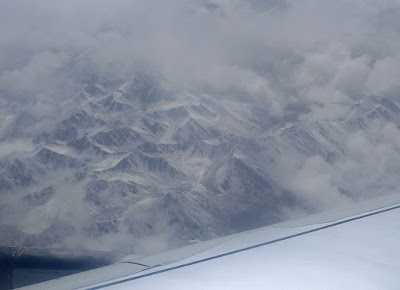 |
| Flying over the Himalayas |
 |
| Approaching Lhasa |
 |
| Arrival at Gonggar International Airport in Lhasa |
Tibet is officially part of China, although many of the citizens might disagree, if they could. The Chinese refer to it as the "Tibet Autonomous Region". One of the differences between Lhasa and Beijing is that we saw lots of propaganda-type signs and billboards around Lhasa, and almost none in Beijing (unlike in 1987).
 |
| A typical sign at the Lhasa Airport |
On arrival at the airport, we were met by our guide Lhamor, and driver. From the airport, we drove about 45 minutes to our hotel.
 |
| On the way in from the airport |
The area between the airport and central Lhasa is undergoing a lot of new construction, and does not look like one would expect Tibet to look like.
We eventually arrived at the Xin Ding Hotel. Unlike our hotels in Ulaanbaatar and Beijing, which catered to a largely western clientele, the Xin Ding seemed to be oriented towards Chinese tourists. The hotel staff wasn't terribly fluent in English, and the rooms and public areas reminded me more of the hotels we stayed at in 1987 than our hotels in Ulaanbaatar and Beijing.
 |
| Entrance to the Xin Ding Hotel |
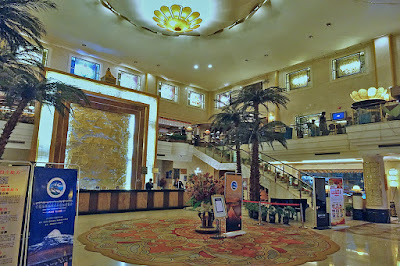 |
| Hotel Lobby |
 |
| Our hotel room |
Lhasa is at 12,000 feet and during our stay in Tibet, all three of us suffered from altitude sickness, the symptoms of which included headaches, insomnia, and (at least in my case) a general lack of appetite. The good news is that oxygen tanks were included in each guest room. The bad news is that the English instructions appear to have been written by running the Chinese instructions through Google Translate. I dare you to interpret the instructions below:
For lunch, we went to the hotel restaurant, where no English was spoken. Below is an excerpt from the menu.
 |
| Mmmm...thickening Cowboy Bone! |
The rest of the day was devoted to staying in the room and getting acclimated to the altitude. One of the nice things about the hotel was that there was a terrific view of the Potala Palace (which was about 3 miles away) from our room. The Potala Palace was the home of the Dalai Lama, before he was exiled, and is the most famous site in Tibet.
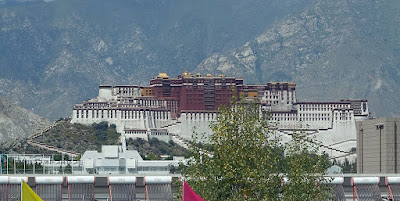 |
| Potala Palace by day |
 |
| Potala Palace by night |
Day 12: Lhasa
After breakfast, we headed to the northwest part of Lhasa to
Norbulingka, a complex which served as the summer residence for several Dalai Lamas.
 |
| Boulevard in central Lhasa |
 |
| Near the entrance to Norbulingka |
 |
| On the grounds of Norbulingka |
 |
| Kalsang Palace, built in the 1700's |
 |
| Summer residence |
We then headed back into the center of Lhasa. Central Lhasa consists mostly of 3- and 4-story buildings with lots of decorations.
 |
| Street corner in central Lhasa |
 |
| Potala Palace, from the center of town |
 |
| Another Lhasa street scene |
 |
| No, it's not a Nazi trash can |
We stopped for lunch at a coffee shop that served both bagels and yak pizza.
 |
| A Tibetan bagel--no idea where they get them |
 |
| Yak pizza! |
After lunch we went to see the
Jokhang Temple, which is on
Barkhor Square, one of the main squares in Lhasa.
 |
| Barkhor Square |
 |
| Jokhang Temple--the smoke is incense |
 |
| Another side of Barkhor Square |
There was very heavy security in the area, in the form of Chinese troops.
Below are more shots from Barkhor Square:
Eventually, we went into the Jokhang Temple, the oldest part of which dates from 652 (no, I didn't leave off a "1"). A lot of people make pilgrimages to this and other temples in Lhasa from the countryside. Apparently the designs on womens aprons represent where they come from.
 |
| Entrance to the temple |
 |
| Inner courtyard of the temple |
 |
| Some temple artwork |
We then wandered the streets around the temple. They were filled with shops and restaurants.
 |
| Lhamor, Carol, and Brenda |
 |
| Some of the goods on sale |
 |
| Locals on a bench |
 |
| 2 locals and 2 foreigners on a bench |
 |
| Potala Palace in the distance |
Next was a visit to Potala Palace. Carol and Brenda were exhausted from the morning's activities, so they went back to the hotel and I visited the palace with Lahmor. (I was exhausted too, but nothing was going to keep me from visitng the palace).
Construction on the palace started in 1645, and it is about 13 stories high, with over 1,000 rooms.
It's over 500 steps to the top of the palace, so I committed myself to going at least part way.
 |
| About to begin my ascent |
 |
| Starting the climb |
 |
| About 1/3 of the way up, with a view of the city. I decided to continue on |
 |
| About halfway up, with a view of the square in front of the palace. |
 |
| Panoramic view of the palace courtyard, almost at the top. The building in the center is the White Palace, where the Dalai Lama lived |
 |
| View of Lhasa from near the top |
Somehow, I managed to make it to the top, with several rest stops on the way. Unfortunately, they don't allow photography inside the palace, so below are a couple of pictures I "borrowed" from the Internet:
 |
| The Dalai Lama's bedroom |
 |
| Another shot inside the palace |
After going back to the hotel for a well-deserved rest, we headed out for dinner at the Crazy Yak restaurant, featuring a Tibet folk show.
 |
| On the way to the restaurant |
 |
| The Crazy Yak |
The entertainment was not the most professional I have seen (I think it was done by the restaurant staff).
Day 12: More Monasteries Around Lhasa
The morning and afternoon were dedicated to visiting the Drepung and Sera monasteries in Lhasa. Our first stop was
Drepung, which is in the northwest part of Lhasa. Drepung was founded in the 15th century and is the largest Buddhist monastery in Tibet
 |
| Entrance to Drepung Monastery |
 |
| General view of Drepung |
 |
| In front of the Great Assembly Hall |
They don't allow photography inside the monastery, so here's an image from inside the Great Assembly Hall that I "borrowed" from the internet:
For some reason, there were lots of dogs lying around every monastery we visited.
From Drepung, we headed across town to Sera Monastery, with a stop for lunch.
 |
| Road construction near Sera Monastery |
 |
| Lunch in a coffee shop near Sera Monastery |
Another word about Chinese (and Tibetan) toilets. A friend of mine who has traveled extensively in China told me that most toilets in residences are Western style, but public toilets (even the "modern" one shown here), are "squatters".
After lunch, we headed over to the
Sera Monastery, which was founded in 1419.
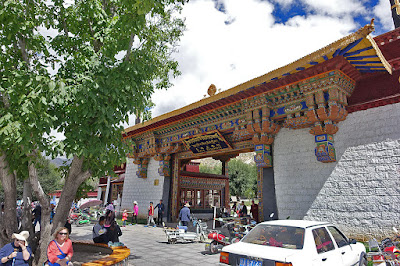 |
| Entrance to Sera Monastery |
 |
| A local visitor--lots of people had ash marks on their noses, which has some religious significance |
 |
| Potala Palace in the background |
After visiting the monastery, we went back to the hotel. Brenda and I decided to go back to Jokhang Temple and Barkhor Square in the center of the city for dinner, but Carol was tired and stayed at the hotel.
 |
| Near Barkhor Square |
 |
| Also in central Lhasa |
 |
| Yet another view of Potala Palace from central Lhasa |
 |
| Barkhor Square |
We wandered some of the back streets near Barkhor Square that were less tourist oriented.
 |
| Cat Head Laundry Detergent |
 |
| A souvenir purchase |
 |
| Beijing Road, a major avenue in Lhasa |
We ate dinner at the Dunya Restaurant and Bar, which appears to be the
second most highly-rated restaurant in Lhasa. It's owned by a European and American, and serves the best yak steak in Lhasa (so they say).
After dinner, we headed back to the hotel, passing by Times Square on the way.
 |
| Times Square |
Day 13: Lhasa to Shigatse
Today, we headed out to visit the towns of Gyantse and Shigatse, about 170 miles from Lhasa. The route would take us through some mountain passes at about 15,000 feet.
 |
| Heading out of Lhasa |
 |
| A few miles from Lhasa |
 |
| Well supplied with a map and a bottle of oxygen |
 |
| Some typical houses in the countryside |
Along the way, we stopped at a mountain pass at an altitude of 15,000 feet, which I think is a record for me.
There were several opportunities at the pass to take pictures with various Himalayan animals
 |
| Local native with a yak |
We traveled on to a pass near
Yamdrok Lake, which was a stunning blue (the lake, not the pass). More photo opportunities with local animals awaited us.
 |
| Yamdrok Lake |
We stopped for lunch in the town of Nagarze.
 |
| Downtown Nagarze |
 |
| Lhasa restaurant in Nagarze |
 |
| On the menu at the Lhasa restaurant. I passed on the yak tongue. |
 |
| Inside the Lhasa restaurant |
 |
| On the streets of Nagarze |
Filled with Tibetan food, we went back on the road to Gyantse, with some nice mountain scenery on the way.
 |
| Always time for souvenir shopping |
 |
| There were lots of these prayer flag displays on our route |
We arrived in
Gyantse in the late afternoon.
 |
| Central Gyantse |
 |
| On the streets of Gyantse |
The two main attractions are the
Gyantse Dzong, a fort built in 1390 on a hill overlooking the town, and the
Palcho Monastery.
 |
| Gardens at Palcho Monastery |
 |
| View of Gyantse Dzong (in the distance) from Palcho Monastery |
 |
| Main temple at Palcho Monastery |
The Palcho Monastery was one of the few where we could take pictures inside, so here are a few:
 |
| The candles are made from yak butter |
 |
| In the main temple |
 |
| Prayer books |
Next to the main temple is the
Kumbum, a multi-story collection of chapels.
 |
| Another shot from the monastery |
On the way out, we got a better view of
Gyantse Dzong, but we didn't actually visit it.
 |
| Gyantse Dzong from the road |
From Gyantse, we headed on to Shigatse, our destination for the night. Along the way, we passed lots of countryside houses.
At about 7:00 PM, we arrived in Shigatse. There was still plenty of daylight left because China has one time zone for the entire country. So, it was 7:00 in both Beijing (where it was dark) and in Shigatse, 2,400 miles to the west. Shigatse is the second largest city in Tibet, with a population of 117,000 (which tells you something about the population density of Tibet).
 |
| Apartments under construction on the edge of Shigatse |
 |
| Central Shigatse |
Our accommodations in Shigatse were at the
Tsahi
Choe Ta Hotel, and were pretty similar to what we had in Lhasa.
 |
| Tsahi Choe Ta Hotel |
 |
| Hotel lobby, with a couple of Buddhist monks checking in |
 |
| Our hotel room |
Our hotel was close to a pedestrian mall, so we walked to the Songtsen Tibetan Restaurant for dinner.
 |
| I had the sizzling yak platter, and a Budweiser |
 |
| Inside the restaurant |
Day 14: Shigatse, and Back to Lhasa
After breakfast, we visited the
Tashi Lhunpo Monastery, in the middle of Shigatse. The monastery was founded in 1447 by the first Dalai Lama. Several photos from the monastery are below:
 |
| Tashi Lhumpo Monastery |
After visiting the monastery, we headed back to Lhasa.
 |
| Leaving Shigatse |
 |
| A school on the outskirts of Shigatse |
Along the way, we stopped at a house in the countryside to visit a "typical" Tibetan family. We were invited in for some yak butter tea.
 |
| Pouring the tea from an electric blender into a thermos |
 |
| Presumably the TV works |
Yak butter tea tastes like melted butter, watered down with tea. It's an acquired taste, and the taste was not acquired by all members of our party.
 |
| Enjoying(?) yak butter tea |
 |
| One of the sleeping rooms |
 |
| Inner courtyard of the house, with the family's grandmother in background |
 |
| Another sleeping room |
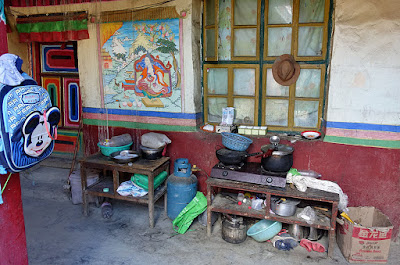 |
| Cooking utensils in the courtyard |
The toilet facilities were out back. Literally out back as in "go out back and do it in the field"
 |
| Carol heads to the facilities |
While we were visiting, the family's children came home from school.
China has very tight restrictions on travel in Tibet. You need a permit to enter Tibet, and foreigners can travel outside of Lhasa only with a registered guide. Lhamor, our guide, was required to check in at various check points along the way. In fact, you had to check in at specific times--if you checked in early, it meant that you were probably speeding. In our case, we often arrived at checkpoints early, so we had to stop a couple of mile before the checkpoint and wait for 5 or 10 minutes.
 |
| Lhamor at a checkpoint |
 |
| Our route back to Lhasa paralleled a newly-built railroad |
 |
| A dummy cop to thwart speeders |
Along the way, we stopped for lunch in the middle of nowhere at the Nimu Fuhua restaurant.
 |
| Nimu Fuhua restaurant |
The food was decent (I had fried rice), but what distinguishes the restaurant is possibly the worst restroom I've ever encountered. Literally holes in the ground that emptied out into an exposed pipe. However, the restrooms were labeled in English as "boy" and "girl", so I'll give them credit for that.
 |
| Restrooms at Nimu Fuhua Restaurant |
 |
| Employees in the restaurant watching TV |
Eventually, we made it back to Lhasa in the late afternoon/early evening.
 |
| A Geely "Trumpchi" |
 |
| Southern Lhasa |
 |
| Today's view of the Potala Palace |
Day 14: Lhasa to Shanghai
Our flight wasn't scheduled to leave until 3:00, so I took the opportunity to visit the supermarket across the street from our hotel. Not a word of English was spoken there.
 |
| The Supermarket |
 |
| What they're drinking in Lhasa |
 |
| Inside the market |
 |
| If I were naming toilet paper, I wouldn't call it "Face" |
After my shopping trip we headed to the airport for (what was supposed to be) a 3:15 flight.
 |
| As you can clearly see, our flight is delayed |
 |
| I probably wasn't supposed to take a picture of this |
We eventually took off at about 5:00. We had to change planes in Xian, and didn't arrive in Shanghai until about 10:30.
 |
| Part of Lhasa from the air |
Next --
Days 16-19: Shanghai















